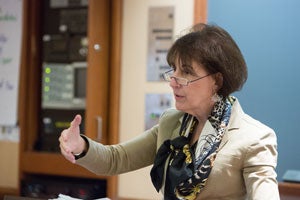Textile imports from China. Trade gaps with Japan. Pirated music in Canada. World Trade Organization technology tariffs. These are just a few of the issues Ambassador Charlene Barshefsky negotiated as United States Trade Representative from 1997 to 2001. On October 3, Barshefsky came to Harvard Law School to share her experiences with students in the Advanced Negotiation Workshop taught by Clinical Professor Robert Bordone ’97 and Lecturer Rory Van Loo ’07, director and assistant director of the Harvard Negotiation & Mediation Clinical Program (HNMCP).
As a young attorney at Steptoe & Johnson, Barshefsky rapidly developed expertise in trade disputes. In 1993, the Clinton Administration asked her to serve as a deputy U.S. trade representative. Soon after her confirmation, Barshefsky took up negotiations with a close U.S. ally, Japan. The trade gap between U.S.-Japanese exports and imports had ballooned, to Japan’s advantage. Barshefsky had to close the gap.
A few years later, this time as the Cabinet-level U.S. trade representative, another problem emerged in Asia. China’s pirated media production and exports were out of control, and China ignored previously signed intellectual property protection agreements. Barshefsky had to both reduce the rate of piracy and establish long-term methods to enforce IP rights.
Comparing her negotiations in Japan and China, Barshefsky discussed the importance of knowing the context in which the other party is operating. Japan and the U.S. understood each other’s goals and had a long history of trade negotiations. China, however, was a tabula rasa; at that time, few U.S. officials had expertise in Chinese affairs, let alone in the Chinese decision-making process. In the Japanese negotiations Barshefsky focused on the negotiation dance itself. When it came to China, she had to lay much more groundwork.
Since China lacked context for discussing IP (in Chinese culture, copying was a sign of flattery and private property rights were non-existent), Barshefsky had to create it by educating Chinese officials on the importance of IP protections for the country’s development and innovation aims. Building relationships over many months, she learned who made decisions, how various governmental players impacted agreements, and what areas of China’s economy would be most impacted by IP enforcement.
Once she understood the landscape, she could articulate with specificity the goal for IP enforcement. This phase—setting and articulating the goal— is the most important in a negotiation, she told the students.
“The goal tells you what you need to know. It informs who should be at the table, and which parties are extraneous,” Barshefsky explained. “If the goal is framed too broadly, the results are likely to be ambiguous and unenforceable. If the framing promises too much, parties will walk away feeling deceived.” Barshefsky reminded students that they can always pause, regroup, and reframe the proposition.
Students in the Advanced Negotiation Workshop wondered how Barshefsky handled parties peripheral to the China negotiations, especially human rights advocates and U.S. labor organizations. Barshefsky cautioned that a negotiator has to carefully balance stakeholder concerns. In the broadest sense, however, “negotiations are not social events, and everyone you invite will either help you reach the goal, take up time, or dilute the process,” she instructed. “Once the goal embodies the views of stakeholders, negotiations become highly intense and the number of parties necessarily limited.”
The commercial negotiation context is different than the diplomatic context, she said. During diplomatic talks, parties can exchange constructive ambiguities—niceties that could be interpreted many ways. But when commercial interests are involved, parties need to be clear, specific, and always benchmark against their goal.
Thanks in part to this strategy, not only did Barshefsky negotiate intellectual property protection with China, but she also secured China’s entrance into the World Trade Organization. How did she do it?
“Clear goals; knowing the terrain both substantive and political; the ability to persuade; and persistence. There’s always a way to pique someone’s interest. There is always a way to articulate a winning argument; there is always a way to find win/win solutions. You just have to be agile,” she advised. Her agility won over the Chinese negotiators.
Barshefsky’s stories clearly resonated with the HLS students. “Her negotiation toolbox is overflowing, and we all became more strategic negotiators today because she was willing to share these tools,” said Alexis Beveridge ’13.
“Ambassador Barshefsky’s stories of success and challenge as a negotiator, both while she was the U.S. trade representative and since then, brought to life some of the central themes of multiparty negotiation,” said Bordone. “Hearing her deconstruct her approach to goal-setting and preparation demonstrated the discipline and perspective-taking that make for great negotiators.”
—Heather Kulp, Clinical Fellow, Harvard Negotiation & Mediation Clinical Program (HNMCP)
